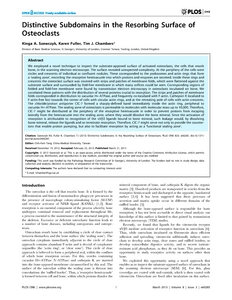Szewczyk, KA; Fuller, K; Chambers, TJ
(2013)
Distinctive subdomains in the resorbing surface of osteoclasts.
PLOS ONE, 8 (3).
e60285.
ISSN 1932-6203
https://doi.org/10.1371/journal.pone.0060285
SGUL Authors: Chambers, Timothy John
![[img]](https://openaccess.sgul.ac.uk/101290/1.hassmallThumbnailVersion/pone.0060285.pdf)  Preview |
|
["document_typename_application/pdf; charset=binary" not defined]
Published Version
Download (17MB)
| Preview
|
Abstract
We employed a novel technique to inspect the substrate-apposed surface of activated osteoclasts, the cells that resorb bone, in the scanning electron microscope. The surface revealed unexpected complexity. At the periphery of the cells were circles and crescents of individual or confluent nodules. These corresponded to the podosomes and actin rings that form a 'sealing zone', encircling the resorptive hemivacuole into which protons and enzymes are secreted. Inside these rings and crescents the osteoclast surface was covered with strips and patches of membrane folds, which were flattened against the substrate surface and surrounded by fold-free membrane in which many orifices could be seen. Corresponding regions of folded and fold-free membrane were found by transmission electron microscopy in osteoclasts incubated on bone. We correlated these patterns with the distribution of several proteins crucial to resorption. The strips and patches of membrane folds corresponded in distribution to vacuolar H+-ATPase, and frequently co-localized with F-actin. Cathepsin K localized to F-actin-free foci towards the center of cells with circular actin rings, and at the retreating pole of cells with actin crescents. The chloride/proton antiporter ClC-7 formed a sharply-defined band immediately inside the actin ring, peripheral to vacuolar H+-ATPase. The sealing zone of osteoclasts is permeable to molecules with molecular mass up to 10,000. Therefore, ClC-7 might be distributed at the periphery of the resorptive hemivacuole in order to prevent protons from escaping laterally from the hemivacuole into the sealing zone, where they would dissolve the bone mineral. Since the activation of resorption is attributable to recognition of the αVβ3 ligands bound to bone mineral, such leakage would, by dissolving bone mineral, release the ligands and so terminate resorption. Therefore, ClC-7 might serve not only to provide the counter-ions that enable proton pumping, but also to facilitate resorption by acting as a 'functional sealing zone'.
Statistics
Item downloaded times since 04 Jul 2013.
Actions (login required)
 |
Edit Item |




